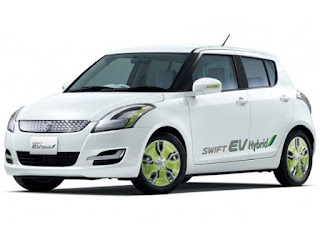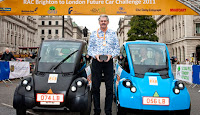The ChargingPoint.com report on the RAC Future Car Challenge, the 60 mile automotive energy efficiency competition, that starts just down the road from my home on the South coast. This year there were 70 entries:
'Gordon Murray maintained a 100 percent RAC Future Car Challenge win record on Saturday after his T.27 pure electric car was recognised as the most energy-efficient vehicle in the 2011 event. Murray, who also penned the McLaren F1 supercar, took the honours in the inaugural event last year with the T.25, a petrol-engined version of the same vehicle.
The Future Car Challenge pits pure electric, hybrid, plug-in hybrid, extended range electric and petrol and diesel vehicles against each other to find out which are the most energy efficient in a run from Brighton, on the south coast of the UK, to Pall Mall in London. Energy use for all types of car is converted to kilowatt-hours.
The 60-mile route is a reverse of the historic London to Brighton Veteran Car Run, which features cars made before 1905 and this year took place the day after the Future Car Challenge. After the completion of the Future Car Challenge on Saturday afternoon, all cars, old and new, are presented in the Regent Street Motorshow – described as “the world’s largest free motorshow”.
The Murray Design T.27’s biggest advantage is its low weight, with the compact design meaning that little energy is needed during operation. According to figures published by Murray Design itself, the T.27 uses 36% less energy per km than the Mitsubishi iMiEV, and 29% less energy than even the tiny Smart electric drive. BMW’s MiniE uses 86% more energy per km, says the company. The T.27's electric drive system was designed in-house, with Murray talking to three manufacturers about possible production.
“This is the only event in the world that demonstrates real cars, in real conditions, that is measured independently and in the public eye,” said Murray after picking up his award. “It’s a fantastic showcase for technology, and the Royal Automobile Club should be proud of the event. Last year we won with our petrol car the T.25 entry and this year our electric car the T.27, both of which clearly demonstrate that light weight is the biggest tool we have for reducing emissions.”
Murray was not the only winner on the day – after the overall winner award, other categories included most energy-efficient small car, regular car, large car, sports car, multi-purpose vehicle and light commercial vehicle, with production cars and prototypes grouped together. There was also a winner in each class of vehicle by power type – pure electric, hybrid, plug-in hybrid and extended range and internal combustion – as well as a People’s Choice award. A full list of winners can be found below.'
2011 RAC Future Car Challenge results:
1. Most Energy Efficient Small Car (Production) - No. 2, smart fortwo electric coupé
2. Most Energy Efficient Small Car (Prototype) - No. 27, T.27 Gordon Murray Design
3. Most Energy Efficient Regular Car (Production) - No. 3, Nissan Leaf
4. Most Energy Efficient Regular Car (Prototype) - No. 43, VW Golf blue-e-motion
5. Most Energy Efficient Large Car (Production) - No. 42, Peugeot 508 e-HDI
6. Most Energy Efficient Sports Car (Production) - No. 18, Tesla Roadster
7. Most Energy Efficient Sports Car (Prototype) - No. 54, Jaguar E-Type
8. Most Energy Efficient Multi-Purpose (Prototype) - No. 41, Proton Exora REEV
9. Most Energy Efficient Light Commercial Vehicle (Production) - No. 46, Mercedes-Benz Vito E-Cell
10. Most Energy Efficient Light Commercial Vehicle (Prototype) - No. 62, Citroën Nemo Van Electric
11. Best Overall Pure Electric Vehicle - No. 27, T.27 Gordon Murray Design
12. Best Overall Extended Range/Plug-In Hybrid (E-REV, PHEV) Vehicle - No. 41, Proton Exora REEV and No. 21, Toyota Prius Plug-In Hybrid
13. Best Overall Hybrid (HV, HEV) Vehicle - No. 68, Honda Insight
14. Best Overall Combustion Engine (ICE) Vehicle - No. 67, Mini Cooper D Olympic Edition
15. Best Overall Vehicle On Sale At Time Of Event - No. 3, Nissan Leaf
16. Best Overall Private Entry - No. 8, Lotus Elise S1 Electric
17. Best Overall Entry - RAC Future Car Challenge Winner, No. 27, T.27 Gordon Murray Design
18. People’s Choice - No. 44, Delta E4 Coupé


































